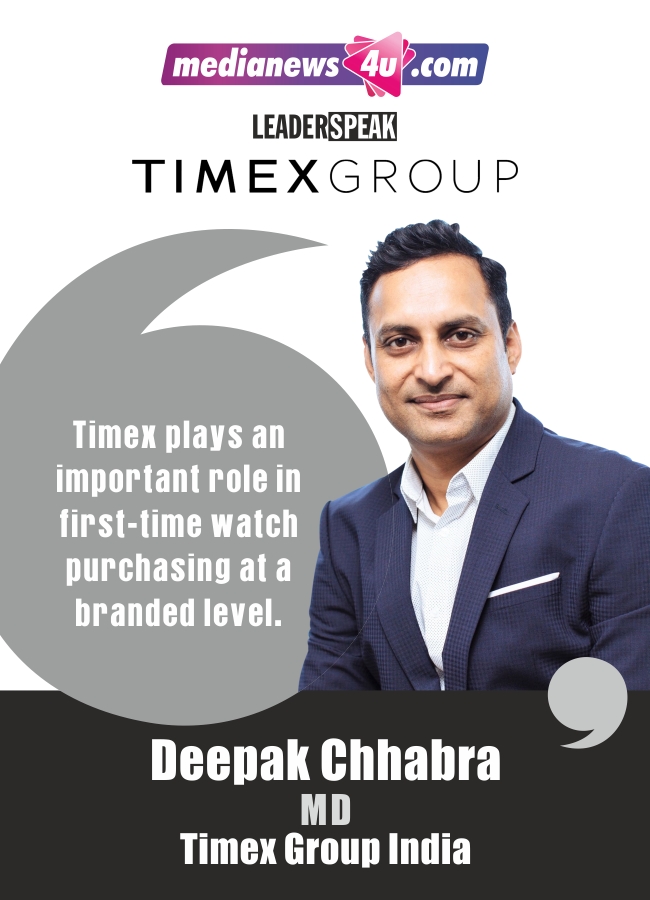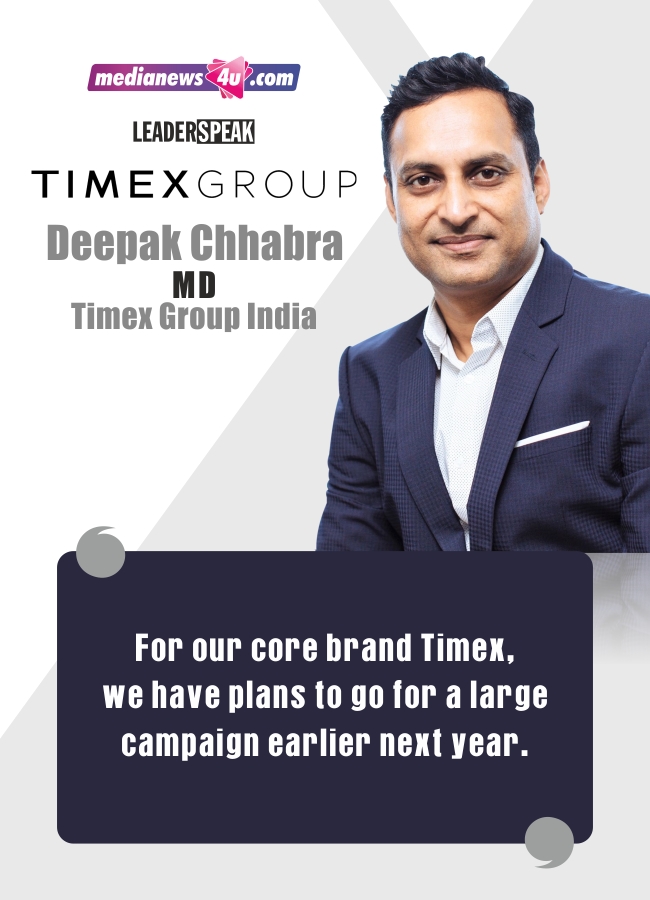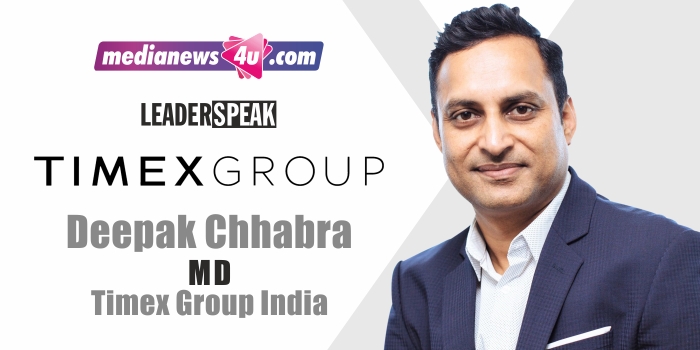While India’s per capita watch penetration is low, those who do buy them are buying more – the top 10 pc who consume watches as accessories are crossing three watches each. “The overall watch consumption is on the rise, which is helping Timex Group as well,” reveals Deepak Chhabra, MD, Timex Group India, in conversation with Medianews4u.com.
Timex Group has been in the news for launching a slew of fashion brands in the country with global licensing arrangements. It has in its fold Guess, Gc, Furla, Ted Baker, Missoni, Adidas Originals, Philipp Plein and UCB, besides Versace and Salvatore Ferragamo in the luxury segment.
Chhabra spoke about the share of owned brands and licensed brands, trends in smartwatches and wearables, marketing strategies and a brand campaign in the works for early 2023, among other things.
What will be the share of owned brands as against licensed brands for Timex in say, the next three years? What is it currently?
Currently, we do about 20 pc from licensed brands and 80 pc is from our own brands. But, with the acquisition of many more brands or distribution agreements we see this moving to about 30 to 35pc. So, two-thirds of our business still remains with our core brands. One third may move to licensed brands in two ways. Firstly, because fashion and luxury watches consumption is increasing due to higher demand for the products. Secondly, because of the acquisition of a few more brands to the group. We currently have 10 brands and assuming one brand to be added each year, in the least, which will make it 15 brands, which itself will give us 15pc more.
Timex has launched Waterbury Ocean collection, an upcycled watch made of ocean-bound plastic to tackle pollution, in July 2022. How has the consumer response been?
Sustainability is taken as one of the considerations by the consumer when they consume anything. Waterbury is made of 100pc sustainable material. It has had a great response and is selling well. This is the collection which will continue for next few seasons. We feel the coming season will be much bigger for the collection. I believe more than the commercial value, it was the commitment of the group toward sustainability and sustainable way of manufacturing, whether it’s the manufacturing process or disposal after usage, which were the main objectives. With the Waterbury collection, we wanted to talk about how responsible and sustainable a brand we are.
Reportedly, after (the peak of) Covid19, health-conscious consumers have increased and are shifting towards smartwatches. How is the smartwatches segment faring for Timex Group? What is the market share of Timex’s smartwatches in India?
Smartwatches globally had attained a huge growth about seven years back, though it has picked up in India only two years ago. One learning is that smartwatches are not cannibalising analogue. They are an add-on watch for consumers. While smartwatches grow by multiples, analogue watches still are growing at a high 20pc.
We wanted to give the consumers options. We initially started selling bands, then wearables and smartwatches in the last two and a half years. Currently, it contributes about 15pc to our overall business. We don’t see it going anything beyond this – while we grow the overall business, smart watches will also grow.
If we compare all other smartwatch brands, then our market share would not be even half a pc. This is mainly because the larger chunk of smartwatches are concentrated at lower price points. Brands like Noise, Fire-Boltt, Boat are priced less than Rs.2,000 and majority of business comes from smartwatches priced less than Rs.1,200. We do not play at those price points. But if we put ourselves in the premium smartwatch segment where players like Fossil, Micheal Kors, Amazfit are included, then we would have a share of 4 to 4.5pc.
What is the market share of Timex Group in the Indian market?
The Timex Group owned brands constitute 6pc market share. If we include all the licensed brands together we would be about 8pc.
What are the strategies adopted by Timex to attract more customers to the Timex Group product portfolio?
We believe strongly that there are three factors that we need to work on while planning to acquire a new set of consumers. First one is the product which needs to appeal to consumers. Second is communication and the last one is the channel through which the communication has to reach consumers.
Candidly speaking, we do have a struggle in attracting the young consumers to the brand. Generally, legacy and contemporary are on loggerheads. The challenge which we have is that we have a big legacy which becomes a disadvantage because you have seen your previous generation wearing it. Somewhere the youth starts drifting away from the brand if there is a lack of communication or product innovation or if you don’t sell where they want to buy the product. This becomes a challenge and after some time it starts affecting the numbers.
What we have done is that we have a very large fashion line within the Timex Group. We have addressed the issue with product offerings. About 25pc of our product offering is high fashion which is actually for the 18 to 24 age group. Secondly, we are selling through digital channels and also through organised format stores, where these youth make purchases.
Third, our entire communication, marketing, and advertising strategies are digital first – what they consume. We are finding several positive benefits out of these strategies and will continue the same.
Which are the most popular products / brands of Timex Group in India?
In the luxury segment, Versace is doing amazing numbers and it’s growing at a faster rate. It’s a brand which is very relevant for Indians because it’s a high fashion brand and a lot more flashy, which is suited for Indian taste as compared to other competitive brands which are more subtle. Versace being a maximalist brand has a lot of flaunt value. In the fashion segment, Guess is performing well.
Then we launched a collection called Fria – which is an occasion wear women watches collection which is doing amazingly well. The automatic collection for men is also a star performer in the last one and half years.
What are the watch purchase trends you have observed among the Indian consumers? Is there a rise in the purchase of luxury watches?
The luxury segment is doing very well. Because of the pandemic people have realised the uncertainty of life. There is a need to save money, but there is realisation that there should be a percentage to it. People realised that they should indulge rather than only save. One comes to indulgence with the thought that you want to do more than you could have afforded sometime back. That’s where the luxury segment is growing at a faster pace.
Watch as an accessory in the fashion segment is also growing. People who used to spend Rs.5,000 to 6000 for a watch have gone beyond Rs.10,000, which is leading to a huge growth in the fashion segment. The segment is growing at 40 pc.
The third biggest segment which is growing for us is the first-time watch ownership. In India half the population could never afford watches, but with general economic stability and realisation of indulgence even those sections of people are consuming watches.

Timex plays an important role in first-time watch purchasing at a branded level. TMX has a significant business, the business has quadrupled largely driven by geographies where the consumption was very poor. Uttar Pradesh was the leader among the geographies, Madhya Pradesh also did well. Places like Jharkhand, Bihar, and Assam have seen a huge surge in the low-end segment.
North leads the pack for us, accounting for 30pc of our business, followed by West which is about 27 to 28pc. Then South accounts for 25 to 26pc. In the East we are a little weak and I believe that is the trend for a majority of the brands. East accounts for 12 to 13pc.
Can you throw some light on the marketing and advertising spends of the brand?
We don’t intend to do any ATL activities for the luxury segment because only niche consumers can afford the segment. Largely it’s customised digital communication and events.
For the fashion segment, social digital becomes important. The segment largely works on influencers. We have a set of macro, mid-tier, and macro influencers who work with us. We do a lot of investment at the point of sale because today it is a very competitive environment and you need to grab the consumers’ eyeballs. We are not keen on ATL on this segment as well.

For our core brand Timex, we have plans to go for a large campaign earlier next year. At this point we are trying to finalise a face for the campaign. The campaign will be ATL, probably it won’t be print – more audio-visual, TVCs, digital, OOH and influencer activity.
How are Timex’s products faring in the online retail channels?
We believe that we have to be everywhere our consumers are. Online is the channel which none of the brands can afford not to participate in. We also firmly believe that offline has limitations of how many places you can be at, which online can do.
Online retail space is very cheap where you can showcase all your products together. Covid has also taught us how to buy bread online, that trend is not going anywhere. Online has stabilised itself as a preferred mode of shopping especially for products which are size-agnostic.
Our focus will remain growing the online network. A fourth of our business comes from online which is in line with the industry ratio.

















